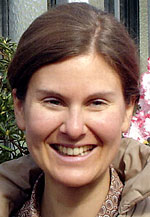 On Saturday, 3 September, 32-year-old Celine Henri signed her name into the entrance book at the gate of the Nagarjun Forest at 12.05 PM. She never signed out. No one has seen or heard from her since.
On Saturday, 3 September, 32-year-old Celine Henri signed her name into the entrance book at the gate of the Nagarjun Forest at 12.05 PM. She never signed out. No one has seen or heard from her since.
That morning Henri, who served in Nepal as a volunteer, stored her luggage at Hotel Pilgrim in Thamel and told the receptionist she would be back by evening. Family and friends raised the alarm only a month later when they hadn't heard from her.
Under pressure from Henri's family, French ambassador Michel Jolivet decided to investigate himself. A trekking guide said he had seen someone fitting Henri's description  climbing to the summit of Nagarjun on 3 September. The French Embassy checked the register at the gate of Nagarjun and found Henri's name. On 16 October, Jolivet and embassy staff retraced Henri's steps and 20 minutes climb above the twin helipads on Nagarjun's east ridge they came upon a water bottle, a black jersey and a bra. They immediately called the police from a mobile phone who arrived with sniffer dogs. The police found fresh blood stains, a hair clip and a spot where the high grass had been trampled.
climbing to the summit of Nagarjun on 3 September. The French Embassy checked the register at the gate of Nagarjun and found Henri's name. On 16 October, Jolivet and embassy staff retraced Henri's steps and 20 minutes climb above the twin helipads on Nagarjun's east ridge they came upon a water bottle, a black jersey and a bra. They immediately called the police from a mobile phone who arrived with sniffer dogs. The police found fresh blood stains, a hair clip and a spot where the high grass had been trampled.
The French were puzzled: Henri had been missing for more than a month yet the blood was fresh and grass in the monsoon doesn't stay crushed like that. What they didn't realise was that they had discovered the spot where a 31-year-old German woman, Sabine Gruneklee, had been killed only the day before.
Gruneklee had left the Blue Horizon hotel in Thamel on the morning of 15 October. Her disappearance was discovered only a week later when her Australian friend Peter Dulan arrived in Kathmandu and didn't find her in the hotel. The two were supposed to go on a trek to the Khumbu. The German Embassy was notified, and on a hunch it checked the Nagarjun register. Sure enough, Gruneklee had signed her name at 10.20 AM on 15 October.
What the French ambassador had found was the site of Gruneklee's murder. So where was Henri? Nepal police under the direction of the Crime Investigation Division led by SP Kesh Bahadur Shahi investigated and the army unit at Nagarjun searched the area but came up with no clues. SP Shahi was, on Wednesday, promoted to the Kathmandu District Police and is not clear on who is now in charge of the investigation.
Under pressure from Henri's family, the French ambassador decided to return to Nagarjun with a unit of French Police that was in India at the time. What they discovered was shocking: items belonging to Henri and Gruneklee were scattered all across the mountain. Strewn in the dense undergrowth on either side of the trail, Jolivet found Henri's keys, torn papers in German and Gruneklee's driving license. Henri's brother who had joined the search found torn pages of his sister's passport. Beyond the summit on the other side of the mountain, the search team found torn pictures of Gruneklee and a nail clipper.
The Nagarjun Forest on the western rim of the valley used to be a royal hunting reserve and serves as a nature sanctuary. Tourist guidebooks mention the reserve as an ideal spot for birdwatching and to acclimatise before a trek. There is a Buddhist shrine on the 2,600m summit, which the Newars call Jamacho. Pilgrims make the two-hour climb from the base of the hill during the frequent festivals held there.
The 16 sq km forest has a high perimeter wall and has served as a retreat for generations of kings, who have held special meetings there. The gate is guarded by a unit of the Royal Nepali Army. A dirt road snakes to the top and on weekends there are up to 50 visitors, some on motorcycles and cars.
There have been incidents on Nagarjun before. Six months ago, a German woman was mugged and gave a description of her attacker to police. Investigators are certain they are dealing with a serial killer who raped and killed the women and then buried them somewhere in the reserve. "Whoever did this knows the place very well and by scattering the items all over the park is taunting the police, which is the typical psychology of a killer who will strike again," says one official involved in the investigation.
In the past week, the search has intensified further. German police have arrived with their own sniffer dogs. The investigation has now shifted to the steep northern slope below the summit where there are rocks and caves.
Friends and relatives in France and Germany have been posting messages about the slow pace of the investigation and the mainstream media in those countries has started writing about the disappearances. It is only a matter of days before Nepal will hit the headlines in Europe.
There are some notable facts: both disappearances happened on Saturdays, the day of the week when Nagarjun sees most visitors. Both were European women in their early 30s travelling alone. Although the forest gets an average of only 50 visitors on weekends, on 3 September there were 150 entries because there were school children on an outing.
"In most serial killings the murderer is found before the bodies are found," said an official close to the investigation. Police say they are following a few leads and have examined the list of people who entered Nagarjun on both 3 September and 15 October.
For now, the first thing that should be done is to post signs in Thamel and at the entrance to Nagarjun warning visitors not to climb alone.
TIMELINE
3 September Celine Henri leaves hotel and signs Nagarjun register at 12.05PM
7 October Henri's family notifies the French Embassy
15 October French Embassy finds Henri's name on Nagarjun register
15 October Sabine Gruneklee signs Nagarjun logbook at 10.20 AM
16 October French Ambassador Michel Jolivet finds what he thinks are Henri's effects
18 October Gruneklee's friend Peter Dulan reports her missing
20 November Gruneklee's name is also found on Nagarjun register
24 November French team finds Henri's and Gruneklee's items all over the mountain
1 December German Police team arrives with sniffer dogs
"Ali ali naramro"
Sayuri is a professional river rafting guide from Japan who had just finished an adventurous trip down the Tamur River in eastern Nepal. She loves this country and is learning Nepali despite her traumatic experience.
On the flight to Bangkok last week, 28-year-old Sayuri had a bruised face, a gash near her right eye and cuts on her head. She told us her story.
First, it was the Maoists along the Tamur River-everyone in her expedition was forced to pay Rs 5,000 each. "You pay, you can go up. If you don't, you go back. If you don't pay and go up, we kill you," was the stark message relayed through the guide. So everyone in the group of 20 rafters paid up.
After the trip, she decided to go to Pokhara. Her friends in Japan had told her she should see Machapuchre from Sarangkot. Early morning on 20 November, Sayuri started walking to the top, took pictures and talked to tourists along the way. Her guidebook said she could descend the steep stone steps to Phewa. The book also said it was safe to walk alone.
Halfway down, three boys came up from behind. "Give us money," one of them said. Sayuri lied and said her guide was coming along but they started to hit her. She panicked and started screaming. One of them covered her mouth and tried to choke her. They hit her again and she fell. They kicked her in the head, hit her in the face and tried to take her backpack. Soon, they had the bag and the three ran off in three different directions up the slope.
Villagers heard her cries and took her to hospital where her head wounds were stitched up. The police came and took a description of the boys. The most vicious one had a red t-shirt, curly hair and a round face. A week before, a German man and a Japanese trekker were also mugged by three boys at the same spot. Two women from France and Germany were robbed at knifepoint at Ghorepani in October and another German woman was robbed in the thick forest below the peace stupa. Police asked Sayuri to stay an extra two days in Pokhara to identify suspects but they weren't the ones who robbed her.
Sayuri dozes off on the plane-she hasn't slept for days. She lost two cameras: a Casio digital and a Fuji, Rs 4,000 and $ 11 in cash. But it was neither this nor the physical wounds that worried her as she flew out. It was the psychological impact and her concern about what is happening to Nepal.
Sayuri hasn't given up on Nepal. She has her 'Teach Yourself Nepali' book in Japanese and is determined to return. As the plane descends into Bangkok, she says in Nepali: "Nepalmaa ali ali naramro bhayo."


